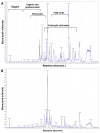Antimicrobial Activity of Arthrospira platensis-Mediated Gold Nanoparticles against Streptococcus pneumoniae: A Metabolomic and Docking Study
- PMID: 39337576
- PMCID: PMC11432420
- DOI: 10.3390/ijms251810090
Antimicrobial Activity of Arthrospira platensis-Mediated Gold Nanoparticles against Streptococcus pneumoniae: A Metabolomic and Docking Study
Abstract
The emergence of antibiotic-resistant Streptococcus pneumoniae necessitates the discovery of novel therapeutic agents. This study investigated the antimicrobial potential of green-synthesized gold nanoparticles (AuNPs) fabricated using Arthrospira platensis extract. Characterization using Fourier transform infrared spectroscopy revealed the presence of functional groups such as ketones, aldehydes, and carboxylic acids in the capping agents, suggesting their role in AuNP stabilization. Transmission electron microscopy demonstrated the formation of rod-shaped AuNPs with a mean diameter of 134.8 nm, as determined by dynamic light scattering, and a zeta potential of -27.2 mV, indicating good colloidal stability. The synthesized AuNPs exhibited potent antibacterial activity against S. pneumoniae, with a minimum inhibitory concentration (MIC) of 12 μg/mL, surpassing the efficacy of the control antibiotic, tigecycline. To elucidate the underlying mechanisms of action, an untargeted metabolomic analysis of the A. platensis extract was performed, identifying 26 potential bioactive compounds belonging to diverse chemical classes. In silico studies focused on molecular docking simulations revealed that compound 22 exhibited a strong binding affinity to S. pneumoniae topoisomerase IV, a critical enzyme for bacterial DNA replication. Molecular dynamics simulations further validated the stability of this protein-ligand complex. These findings collectively highlight the promising antimicrobial potential of A. platensis-derived AuNPs and their constituent compounds, warranting further investigation for the development of novel anti-pneumococcal therapeutics.
Keywords: Arthrospira platensis; Streptococcus pneumoniae; antimicrobial; gold nanoparticles; metabolics; molecular docking; protein-protein interaction.
Conflict of interest statement
The authors declare no conflicts of interest.
Figures















Similar articles
-
Antibacterial, anti-efflux, anti-biofilm, anti-slime (exopolysaccharide) production and urease inhibitory efficacies of novel synthesized gold nanoparticles coated Anthemis atropatana extract against multidrug- resistant Klebsiella pneumoniae strains.Arch Microbiol. 2020 Oct;202(8):2105-2115. doi: 10.1007/s00203-020-01930-y. Epub 2020 Jun 4. Arch Microbiol. 2020. PMID: 32500253
-
Biosynthesis and Characterization of Gold and Copper Nanoparticles from Salvadora persica Fruit Extracts and Their Biological Properties.Int J Nanomedicine. 2022 Dec 7;17:6095-6112. doi: 10.2147/IJN.S385543. eCollection 2022. Int J Nanomedicine. 2022. PMID: 36514376 Free PMC article.
-
Starch-mediated synthesis of mono- and bimetallic silver/gold nanoparticles as antimicrobial and anticancer agents.Int J Nanomedicine. 2019 Mar 27;14:2171-2190. doi: 10.2147/IJN.S192757. eCollection 2019. Int J Nanomedicine. 2019. PMID: 30988615 Free PMC article.
-
Antimicrobial Activity of Arthrospira (Former Spirulina) and Dunaliella Related to Recognized Antimicrobial Bioactive Compounds.Int J Mol Sci. 2024 May 19;25(10):5548. doi: 10.3390/ijms25105548. Int J Mol Sci. 2024. PMID: 38791586 Free PMC article. Review.
-
Advances in delivery methods of Arthrospira platensis (spirulina) for enhanced therapeutic outcomes.Bioengineered. 2022 Jun;13(6):14681-14718. doi: 10.1080/21655979.2022.2100863. Bioengineered. 2022. PMID: 35946342 Free PMC article. Review.
Cited by
-
Nanomedicine: The Effective Role of Nanomaterials in Healthcare from Diagnosis to Therapy.Pharmaceutics. 2025 Jul 30;17(8):987. doi: 10.3390/pharmaceutics17080987. Pharmaceutics. 2025. PMID: 40871010 Free PMC article. Review.
-
Microfluidic Sensors for Micropollutant Detection in Environmental Matrices: Recent Advances and Prospects.Biosensors (Basel). 2025 Jul 22;15(8):474. doi: 10.3390/bios15080474. Biosensors (Basel). 2025. PMID: 40862935 Free PMC article. Review.
-
Beyond the glitter: gold nanoparticles as powerful weapons against multi-drug resistant pathogens.Front Mol Biosci. 2025 Aug 11;12:1612526. doi: 10.3389/fmolb.2025.1612526. eCollection 2025. Front Mol Biosci. 2025. PMID: 40861424 Free PMC article. Review.
-
Assessment of the Nutritional Composition, Antimicrobial Potential, Anticoccidial, and Antioxidant Activities of Arthospira platensis in Broilers.Biology (Basel). 2025 Apr 7;14(4):379. doi: 10.3390/biology14040379. Biology (Basel). 2025. PMID: 40282245 Free PMC article.
References
-
- Gierke R., Wodi A.P., Kobayashi M. Epidemiology and Prevention of Vaccine-Preventable Diseases. Centers for Disease Control and Prevention; Atlanta, GE, USA: 2021. Pneumococcal disease; pp. 279–296.
-
- Sihvonen R., Siira L., Toropainen M., Kuusela P., Pätäri-Sampo A. Streptococcus pneumoniae antimicrobial resistance decreased in the Helsinki Metropolitan Area after routine 10-valent pneumococcal conjugate vaccination of infants in Finland. Eur. J. Clin. Microbiol. Infect. Dis. 2017;36:2109–2116. doi: 10.1007/s10096-017-3033-5. - DOI - PubMed
-
- Örtqvist Å., Hedlund J., Kalin M. Seminars in Respiratory and Critical Care Medicine. Thieme Medical Publishers, Inc.; New York, NY, USA: 2005. Streptococcus pneumoniae: Epidemiology, risk factors, and clinical features. - PubMed
MeSH terms
Substances
Supplementary concepts
Grants and funding
- (NRF-2021R1A5A8032895)/This work was also supported by the National Research Foundation of Korea (NRF) grants funded by the Korean Ministry of Science and ICT (MSIT)
- (RSP2024R111)/This study was supported by Researchers Supporting Project number (RSP2024R111), King Saud University, and Riyadh, Saudi Arabia.
LinkOut - more resources
Full Text Sources
Medical

